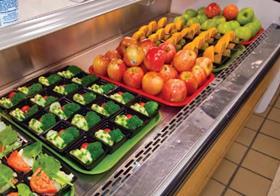
Forcing children to take fruit and vegetables as part of their lunch may be counter-productive, according to a new study published by US-based Public Health Reports.
The study considered the possible impact of the US Department of Agriculture’s National School Lunch Program, which was rolled out in 2012 and requires children to select fruit and vegetables as part of their reimbursable school lunches.
Comparing the amount of fruit and vegetables that elementary schoolchildren selected, consumed and wasted both before and after the scheme was introduced, it found that consumption actually decreased slightly while waste increased compared with when the products’ selection was optional.
That was despite the fact that more children selected fresh produce in higher amounts when taking fresh produce was required compared.
“Children consumed fewer FVs [fruits and vegetables] and wasted more FVs during the school year immediately following implementation of the USDA rule that required them to take one fruit or vegetable at lunch,” said the report’s author Sarah Amin.
“Average waste increased from one-quarter cup to more than one-third of a cup/tray, with about one-eighth cup/tray more FVs discarded, or a total of about 56 cups/day/school (based on an average of 400 lunches served/day).”
However, the report noted that there had been “some promising findings regarding the impact of the new USDA rule”, including an increased percentage of students (28 per cent versus 20 per cent) who consumed at least one serving of fruit and vegetables in a sample of three schools.
“Adjustment to the new requirement may take time, especially because older children were accustomed to having the option of whether or not to choose [fruit and veg],” Amin added.
In conclusion, the report supported the importance of public health practitioners addressing the environmental, home and personal factors that might encourage children’s consumption of fresh produce.



